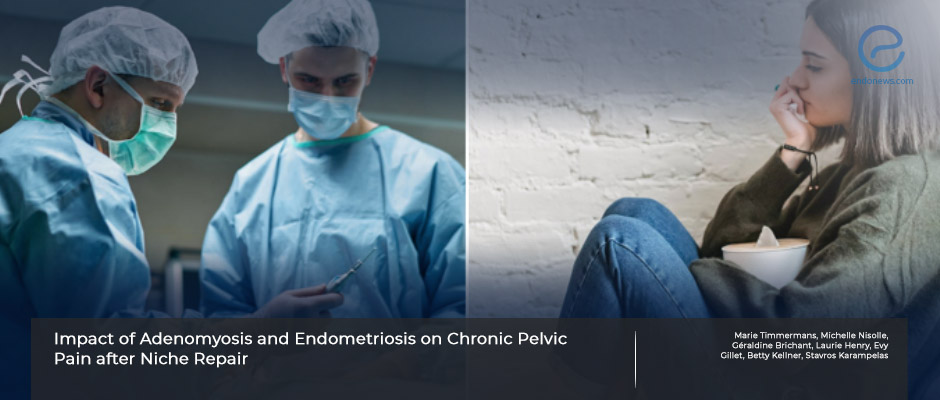Outcomes of chronic pelvic pain after niche repair
Jul 14, 2023
Patient selection for isthmocele and chronic pelvic pain necessitates a preoperative evaluation of adenomyosis and endometriosis
Key Points
Importance:
- The presence of adenomyosis before the cesarian section increases the risk for "isthmocele (uterine niche)".
Highlights:
- The main symptoms of "isthmocele" are chronic pelvic pain, infertility, and abnormal uterine bleeding.
- When a patient needs niche repair, it is essential to know whether she has endometriosis or adenomyosis which causes chronic pelvic pain.
What's done here:
- This is a retrospective study comprising 31 patients with at least one cesarian section who underwent laparoscopically niche repair in a single center in Belgium.
- Patients were divided into 4 groups based on the presence of their previous histological endometriosis or/and adenomyosis diagnoses.
- Any pain that lasted more than six months was accepted as chronic pelvic pain, including dysmenorrhea, dyspareunia, dyschezia, and dysuria.
- The outcome of chronic pelvic pain was evaluated at 3-6 months and 12 months postoperative follow-ups.
Key Results:
- The pre-operative pathological diagnosis of adenomyosis (15 patients), endometriosis (1 patient), both endometriosis and adenomyosis (9 patients), and without any visible pathology other than isthmocele (6 patients).
- Fifteen out of 25 patients (60%) suffering from adenomyosis combined or not with endometriosis were relieved from chronic pelvic pain after 3-6 months of the niche repair.
- Forty percent did not benefit from the reparation surgery regarding chronic pelvic pain. Those who had no improvement had diffuse adenomyosis with or without endometriosis.
- The recurrence and persistence of chronic pelvic pain were higher at 12 months postoperatively.
- In terms of abnormal uterine bleeding, 14 out of 17 patients were relieved from their symptoms after the niche repair.
Lay Summary
Rapidly increasing cesarian section rates in recent years increased the cesarian scar defects and the development of "isthmoceles".
Isthmocele is a myometrial lesion located around the isthmic portion of the uterus that is a myometrial discontinuity or hypoechoic triangle in the myometrium of the anterior uterine wall at the site of hysterotomy. It is generally caused by the improper closure of the muscular layer of the uterus and is also described as the "niche" of the uterus.
Isthmoceles are generally asymptomatic, but a deposit of blood and menstrual debris within the defect can cause fibrotic tissue, slow drainage of menstrual flow, and abnormal uterine bleeding.
Timmermans et al. from the Department of Obstetrics and Gynecology at The University of Liege, Belgium, aimed to clarify the outcomes of "isthmocele" repairs in patients with endometriosis or adenomyosis in the context of pelvic pain.
Analyzing retrospective data from medical records of 31 women having a symptomatic isthmocele with a diagnosis of endometriosis or/and adenomyosis and their surgical outcomes after the niche repair showed a failure to relieve pain symptoms in one-third. This result prompted the authors to warn about the preoperative diagnosis of adenomyosis and endometriosis in patients with chronic pelvic pain, as one-third of these patients could not be relieved after niche repair which would necessitate a discussion of the decision for surgery.
The authors recommended initiating a prospective study with a preoperative imaging checkup to detect endometriosis or/and adenomyosis to evaluate the outcomes of niche repair.
This interesting paper was recently published in the Journal of Clinical Medicine.
Research Source: https://pubmed.ncbi.nlm.nih.gov/37240590/
chronic pelvic pain pain reduction isthmocele secondary infertile niche repair abnormal uterine bleeding adenomyosis endometriosis.

